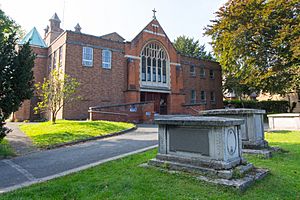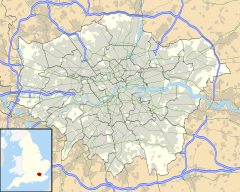Woodford, London facts for kids
Quick facts for kids Woodford |
|
|---|---|
 St Mary's Church, the parish church of Woodford |
|
| OS grid reference | TQ405915 |
| • Charing Cross | 9.5 mi (15.3 km) SW |
| London borough | |
| Ceremonial county | Greater London |
| Region | |
| Country | England |
| Sovereign state | United Kingdom |
| Post town | WOODFORD GREEN |
| Postcode district | IG8 |
| Post town | LONDON |
| Postcode district | E18 |
| Dialling code | 020 |
| Police | Metropolitan |
| Fire | London |
| Ambulance | London |
| EU Parliament | London |
| UK Parliament |
|
| London Assembly |
|
Woodford is a town in East London, England. It is part of the London Borough of Redbridge. Woodford is about 9.5 miles (15.3 km) northeast of central London.
Historically, Woodford was a small area in the county of Essex. It had several small farming villages and was close to Epping Forest. From the 1700s, rich people who worked in London started to live here. Because of its wealth and higher land, some called it the Geographical and social high point of East London.
Woodford became a London suburb. In 1934, it joined with Wanstead and became a borough in 1937. Since 1965, it has been part of Greater London. Woodford includes areas like Woodford Green, Woodford Bridge, Woodford Wells, and South Woodford. Two London Underground stations serve the area: Woodford and South Woodford.
Contents
Woodford's Past
What's in a Name?
The name Woodford comes from Old English words meaning 'ford in or by the wood'. A ford is a shallow place where you can cross a river. The name Wudeford was first used in 1062.
By 1238, a bridge replaced the ford over the River Roding. This led to part of the area being called Woodford Bridge by 1805. Another part of the area became known as Woodford Green by 1883.
How Woodford Grew
Woodford started as a medieval settlement around the ford. It was never just one village. Instead, it was a group of small communities, and it still feels a bit like that today. London has always been important to Woodford's growth.
Epping Forest is a large forest near London. Royal families used to hunt there. This made Woodford attractive to Londoners from the 1400s. Wealthy Londoners began building large homes in the area. Many people living in Woodford at that time were servants.
An example of a grand old house is Hurst House. It's also called 'The Naked Beauty'. The main part of the house was finished in the early 1700s. Later, side wings were added. It was repaired in the 1930s but then damaged by fire. The main part was rebuilt, and you can still see the smaller wings today.
Historians say Woodford's old roads show it was a place where people lived. These roads made it easy to get to Woodford but not much further. There were two main roads. The 'lower road' (now Chigwell Road) often flooded from the River Roding, just like it can today. Even King James I was once held up by this road.
The 'upper road' (now Woodford New Road) was less used and probably in worse condition. In 1721, a group called the Middlesex and Essex Turnpike Trust fixed and improved it. They later took care of the 'lower road' too. In 1828, they built the 'Woodford New Road' from Walthamstow to Woodford Wells.
Becoming a Suburb
The real growth of Woodford as a modern suburb began in 1856. This was when the Great Eastern Railway line opened from Stratford to Loughton. Woodford got two train stations: at Snakes Lane and George Lane.
This new easy transport encouraged more people to live in Woodford and travel to work daily. Woodford quickly became home to well-off city workers. A writer named John Marius Wilson noted in the 1870s that Woodford's population grew because of the railway. He wrote that there were "many fine mansions, and numerous good villas."
Woodford's population doubled in the mid-to-late 1800s because of the railway. Three new churches were built in 1874, showing how fast the area was growing.
Woodford finished becoming a suburb between the two World Wars (1918-1939). Land was quickly built on. The grand old houses were pulled down to make way for middle-class homes. These were often semi-detached houses with three or four bedrooms and gardens. In the 1930s, about 1,600 houses were built in Woodford each year. The Central line extended to Woodford in the mid-1900s, using the existing train tracks. This made Woodford a firm part of London's commuter belt.
Famous People from Woodford
Woodford has been home to many important cultural figures.
- William Morris was a famous writer, artist, and craftsman. He started the Arts and Crafts Movement, which aimed to bring back traditional English artisan skills. He lived at Woodford Hall as a child from 1840 to 1847. Woodford Hall was later pulled down.
- James Hilton was a writer who lived in Woodford Green. He wrote famous novels like Goodbye Mr Chips and Lost Horizon. In Lost Horizon, he created the well-known place called Shangri La.
- Sydney Smith was born in Woodford in 1771. He became a clergyman and a reformer. He is most famous for his clever wit and funny sayings in the early 1800s. He was part of important intellectual groups of his time. He once said about a historian, "He has occasional flashes of silence, that make his conversation perfectly delightful."
- Sylvia Pankhurst was a leading Suffragette, peace campaigner, and anti-fascist. She lived on Charteris Road near Woodford Station for a long time. She was introduced to the area by George Lansbury, who helped start the Labour Party. Sylvia Pankhurst was known for her strong beliefs. She even put up a monument against air warfare to protest the bombing of Ethiopia.
- Richard Warner lived at Harts in Woodford Green. He was the first person in England to grow a gardenia flower. In 1771, he wrote a book called Plantae Woodfordienses. It listed plants growing naturally around Woodford.
Other Notables
- Clement Attlee, former Prime Minister (Woodford Green)
- Derek B, a pioneer of British hip-hop music.
- Nick Berry, actor.
- Sanjeev Bhaskar, comedian and actor (South Woodford).
- Terry Chimes, former drummer for The Clash.
- Winston Churchill, former Prime Minister and MP for the area.
- Vince Clarke, founder of Depeche Mode and member of Erasure (born in South Woodford).
- John Dankworth, English jazz composer and musician.
- Joe Dever, author and games designer (Woodford Bridge).
- Richard J. Evans, historian and author.
- Lynn Fontanne, leading Broadway actress.
- James Hilton, author (Woodford Green).
- Professor Ralph Ambrose Kekwick FRS, biochemist who worked on human plasma.
- Russell Lissack, Bloc Party guitarist.
- Carli Norris, actress.
- Kele Okereke, Bloc Party vocalist and guitarist (Woodford Green).
- Coventry Patmore, poet and critic (born in Woodford).
- Sylvia Pankhurst, suffragette (Woodford Green).
- Peshay, electronic music producer and DJ (South Woodford).
- Ruth Rendell CBE, author (South Woodford).
- Tony Robinson, actor and TV personality.
- Wilfrid Percy Henry Sheldon KCVO, doctor to Queen Elizabeth II.
- George Edmund Street, a leading Victorian architect.
- Meera Syal, comedian, writer, and actress (South Woodford).
- Charles Harrison Townsend, a leading English architect.
- Nigel Travis, CEO of Dunkin' Donuts.
- Christine Truman, Wimbledon-level tennis player (Woodford Green).
- Kate Williams, actress (Woodford Bridge).
Woodford's Location
Woodford is close to several other places:
- Highams Park
- Clayhall
- Wanstead
- South Woodford
- Buckhurst Hill
- Roding Valley
- Loughton
- Chigwell
Getting Around Woodford
Public Transport
The London Underground Central line serves Woodford, South Woodford, and Roding Valley. Trains connect the area to places like Epping and Loughton to the north. Southbound trains go directly to Stratford, The City, and The West End.
The London Overground serves nearby Highams Park station. This line runs between Liverpool Street and Chingford.
Several London bus routes also stop in Woodford. These include routes 20, 123, 179, 275, 549, W13, and W14. Buses connect Woodford to areas like Debden, Wood Green, Ilford, and Walthamstow.
The Night bus route N55 links Woodford to Oxford Circus overnight.
Roads
The A104 road runs through Woodford. It connects the North Circular Road to Epping. This road was once part of the A11 but was renumbered to encourage drivers to use the new M11 motorway instead.
The A113 passes Woodford to the east. It runs between Wanstead and Abridge.
Other important roads include the A121 to Loughton and the A110 towards Chingford.
Some of these roads are part of the Low Emission Zone for older, more polluting diesel vehicles. The A406 North Circular Road separates Woodford from South Woodford. The Ultra Low Emission Zone for lighter vehicles applies only in South Woodford.
The M11 motorway starts in Woodford. It goes around the town on its way to Harlow, Stansted Airport, and Cambridge.
Walking and Cycling
There are cycle lanes along Wanstead New Road (A104). These run between Waterworks Corner and Buckhurst Hill. North of Buckhurst Hill, the route continues to Epping. At Waterworks Corner, an underpass connects Woodford to other cycle paths and footpaths.
The A1199 also has cycle lanes between Woodford and Snaresbrook.
The Roding Valley Walk is a path for both walkers and cyclists. It starts in Woodford and goes towards Ilford.


